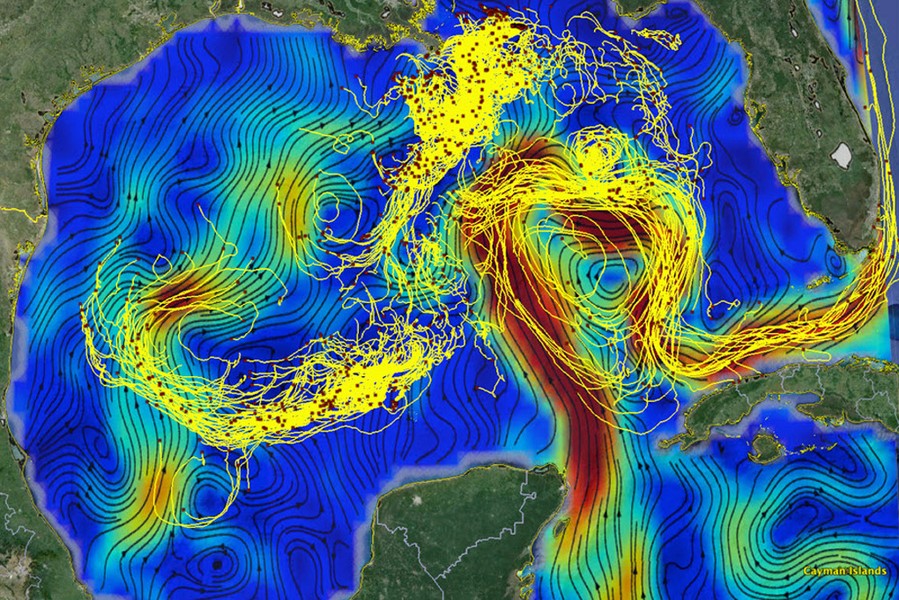Ocean Current Predictions Using Machine Learning
A new machine-learning model makes more accurate predictions about ocean currents, which could help with tracking plastic pollution and oil spills, and aid in search and rescue. [2]
Computer scientists at MIT joined forces with oceanographers to develop a machine-learning model that incorporates knowledge from fluid dynamics to generate more accurate predictions about the velocities of ocean currents. [2]

Figure 1. Ocean Currents (Image: Edward Ryan and Tamay Özgökmen from the University of Miami.)
Figure 1 shows drifting buoy trajectories in the Gulf of Mexico superimposed on surface currents. The red dots mark the buoys’ positions on March 9, 2016, and the tails are 14 days long. [2]
The researchers discovered that due to erroneous assumptions about water behavior, the conventional statistical model frequently applied to buoy data struggles to produce precise predictions. The new model offers a more realistic depiction of the physics at play in ocean currents by combining knowledge from fluid dynamics. [1]
Divergences must be identified, and ocean current predictions must be accurate to respond to oil spills, forecast weather, and comprehend how energy is transferred in the ocean. [1]
The updated model may make more accurate monitoring of biomass transportation, carbon dispersion, plastics distribution, oil movement, and nutrient flow in the ocean possible, which could significantly improve estimates drawn from buoy data. Additionally, this data is essential for comprehending and monitoring climate change. [1]
The researchers found that incorrect assumptions were made regarding the relationship between the latitude and longitude components of the current using the conventional Gaussian process, a machine-learning method used to forecast ocean currents and identify divergences. [1]
The existing model used the false assumption that a current's vorticity and divergence occur on the same length and magnitude scales. The new model, however, includes a Helmholtz decomposition, which divides the ocean current into vorticity and divergence components, precisely representing the laws of fluid dynamics. [1]
Buoyant performance
Researchers have developed a new model for predicting ocean currents and identifying divergences using a Helmholtz decomposition technique. They compared their model's performance to standard Gaussian process and neural network methods using both synthetic and real ocean buoy data. The new model outperformed the other approaches in predicting currents and identifying divergences, even in the presence of vortices. The researchers plan to incorporate a time element into their model and account for noise in the data to improve accuracy. The approach has been praised for its integration of fluid dynamics principles and flexibility in modeling nonlinearity and complex phenomena.
“Our hope is to take this noisily observed field of velocities from the buoys, and then say what is the actual divergence and actual vorticity, and predict away from those buoys, and we think that our new technique will be helpful for this,” she says. [2]
“The authors cleverly integrate known behaviors from fluid dynamics to model ocean currents in a flexible model,” says Massimiliano Russo, an associate biostatistician at Brigham and Women’s Hospital and instructor at Harvard Medical School, who was not involved with this work. “The resulting approach retains the flexibility to model the nonlinearity in the currents but can also characterize phenomena such as vortices and connected currents that would only be noticed if the fluid dynamic structure is integrated into the model. This is an excellent example of where a flexible model can be substantially improved with a well thought and scientifically sound specification.” [2]
Source: MIT
References:
- https://interestingengineering.com/innovation/fluid-dynamics-precise-ocean-current-forecasting
- https://news.mit.edu/2023/new-machine-learning-model-ocean-currents-0517
Cite this article:
Hana M (2023), Ocean Current Predictions Using Machine Learning, AnaTechmaz, pp.433

